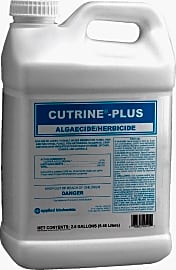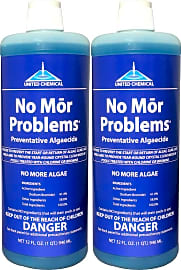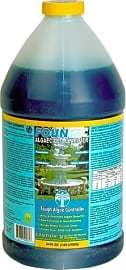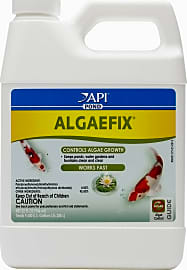The 10 Best Algaecides

This wiki has been updated 32 times since it was first published in February of 2017. It's hard to enjoy a pool or hot tub or admire your pond or fountain when the water is blue, green or yellow and slimy with algae. So we have assembled a list packed with products suitable for a range of budgets and designed to combat various strains of these unwanted little organisms in all of those diverse aquatic settings. Some of them work for spring restarts, too. When users buy our independently chosen editorial selections, we may earn commissions to help fund the Wiki.
Editor's Notes
August 13, 2019:
All of the formulas on this list are designed to be safe, but as with any chemical, it is vital that you read the instructions carefully and only use it in accordance with the manufacturer's directions. Overdosing your water, exposing your skin to the undiluted liquid, imbibing them in any way, or any other use that goes against the recommended guidelines has the potential to be harmful.
If you already have an algae problem in your pool, then you need something designed to kill blooms, rather than a preventative formula. Kem-Tek 60% Concentrate, GLB Pool & Spa Products Strike Out, the PoolRx Mineral Unit, Clorox XtraBlue, In the Swim 60 Plus, and Clorox Eliminator are all good options to do that. Of these, only Kem-Tek 60% Concentrate, the PoolRx Mineral Unit, and Clorox XtraBlue are designed to kill every variety of algae. GLB Pool & Spa Products Strike Out is formulated specifically for green and mustard algae; In the Swim 60 Plus is for black, green, and pink varieties; and Clorox Eliminator is solely for use in controlling green blooms. If your pool is already clean and you just want something affordable that can keep it that way, you may want to look at United Chemical No Mor Problems.
When it comes to ponds and fountains, we also have a few options for you to choose from, each perfect for a specific environment. Cutrine Plus can control a broad range of microorganisms and even works as an herbicide, too. It is suitable to kill large blooms or as a preventative measure, and is safe to use in portable water sources, fish ponds, and plant irrigation reservoirs. EasyCare FounTec is a high-strength formula that only requires a single drop per gallon of water, and while it is safe for birds, plants, and animals, it can harm fish. API Algaefix will harm neither fish nor plants, but can kill off freshwater crustaceans. With this last option however, it is very important that you have a powerful pond pump and run it continuously 24 hours a day, since it can drastically reduce oxygen levels in the water.
October 11, 2018:
Removed discontinued items and added an effective product that works differently than the others. Also ensured that existing items still merit a place on the list.
Why Algae Is Such A Menace
The problem is that these blooms thrive on nitrogen and phosphorous, which they can find in spades thanks to agricultural runoff.
There's nothing more disgusting than waking up early for a quick dip in your pool, diving in, and then coming up to realize you're covered in nasty, green gunk. That's algae, and it's the scourge of just about any outdoor water source you might be trying to maintain.
Algae is a plant, and like any plant, it needs sunlight, water, and other nutrients to grow. If it finds a habitat that offers it an abundance of these things — like, say, your hot tub or birdbath — then it can spread out of control, taking over the entire water source and choking out all other life.
That being said, a little algae is a good thing in aquariums, ponds, and other fish habitats. It can help filter out excess waste from the water and convert it into oxygen via photosynthesis. The problem is, it's extremely difficult to only have a little algae.
Once large collections of algae, or "blooms," begin to form, they can cut off sunlight from reaching the bottom of the pond, as well as suck up all the nutrients before fish or any other plants can get to them. Also, when those large blooms begin to die off later in the year, their decomposition actually takes oxygen out of the water.
The type of algae can have a huge impact on the health of your aquatic ecosystem, as well. One of the most common types, blue-green, can also potentially be one of the worst. Besides just looking disgusting on the surface, it can create foul odors, and occasionally even generate toxins that can harm animals and people, making the water uninhabitable.
The good news is that algae in pools, aquariums, and small ponds is relatively easily to control, provided you stay on top of it. It's a much bigger danger in the ocean and larger lakes and ponds, where it can kill marine life and render seafood inedible.
The problem is that these blooms thrive on nitrogen and phosphorous, which they can find in spades thanks to agricultural runoff. Also, since they love warm water, climate change is making the world a much friendlier place for them, so expect them to be an even bigger problem in the years to come.
Who would've guessed that the biggest menace in the sea wouldn't end up being Jaws, but rather a goopy little microorganism?
Signs You Have An Algae Problem
It's easy to tell you have an algae problem when it gets really out of hand — all you have to do is look down at the thick carpeting of dark green muck where your pool used to be.
Stopping the problem before it gets that bad is a little more challenging, however. Below are some tell-tale signs that algae might be creeping up on you.
This includes pool stairs, rocks in your pond, and around filters and jets.
The color of your water is the first indicator that something wicked might be brewing in your pond. Anything other than clear is a bad sign, so if it's green, yellow, blue, or even black, you should start treating it before it gets any worse.
Each of the colors correspond to a different type of algae, so take note of exactly what shade is being represented in your pool, as they each require different treatment strategies. The most common is green algae, while the most stubborn tends to be the black variety.
Take a look at any nooks and crannies in your structure as well, as that's the first place algae likes to cling to. This includes pool stairs, rocks in your pond, and around filters and jets.
Once you realize that an algae issue is brewing — and what kind of issue you're dealing with — you should take decisive action, so that you can quickly reclaim your water and make it suitable for your fish, or for that wild pool party you've been planning.
Other Ways To Keep Your Water Algae-Free
While algae in the water is something that you can treat, the best way to deal with it is by not letting it build up in the first place.
For pools, this means staying up-to-date on your scheduled maintenance. Have it serviced regularly, and vacuum it periodically to keep dirt and debris from feeding the little spores. Also, since you're here this probably goes without saying, but regular use of algaecide is recommended.
While algae in the water is something that you can treat, the best way to deal with it is by not letting it build up in the first place.
Algae likes still waters, so keep yours moving as much as possible. This means running the filter during the hotter months, as well as actually using the pool, as all your splashing and thrashing will certainly make the bacteria (and possibly your neighbors) unhappy.
If you're trying to keep a pond clean, the most effective way to do so is by limiting the amount of food the algae get. This means preventing fertilizer and animal waste from getting into the water, possibly by building some sort of fence or other buffer zone around the area.
Certain plants can help keep algae under control, especially floating varieties such as water lilies and lotuses. They do this by providing shade, preventing the sunlight that algae needs to thrive from reaching it in the first place. They also chow down on a lot of the same nutrients that the algae covet, giving you an effective one-two punch against slime.
If you're trying to maintain an aquarium, limiting the amount you feed your fish is a good start, as well as putting your lights on a timer. Maintaining your filter, changing the water, and using an algae scraper are all extremely useful strategies, and you can even fill your tank with fish that feed on the little critters.
Ultimately, however, regardless of what kind of water source you're protecting, you're likely going to have to make your peace with having at least some algae. That's OK, so don't let this turn into an obsession.















